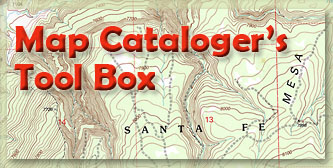| 1XX
/ 7XX Name Headings
Main Entry
Punctuation is as specified in AACR2 (with some
changes according to LC practice).
"Start a new paragraph for each note, end each
paragraph with a period or other mark of final punctuation, and, if
the mark of final punctuation is a closing bracket or parenthesis, add
a period."
Note that when a note ends with a "]"
or ")" the field still ends with a period. Most fields
in map records end this way, as opposed to monograph, serial, and other
format records.
The following are typical notes describing common
aspects found on maps:
Accompanied by: Djurberg, Daniel. Forklaring
til Karten over Polynesien. Stockholm : Holmberg & Wennberg, 1780.
27 p. ; 20 cm.
Original version: A map of Virginia and
Maryland / F. Lamb, sculp. [London] : Sold by Thomas Basset and
Richard Chiswell, [1676?]. Appears in John Speed's The theatre of
the Empire of Great-Britain, 1676. |

